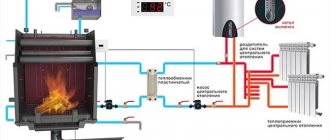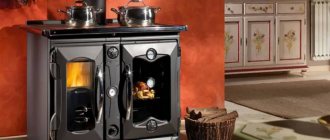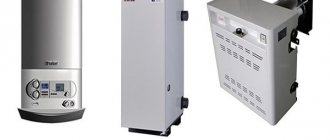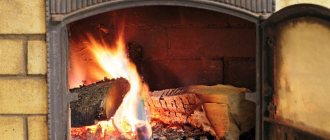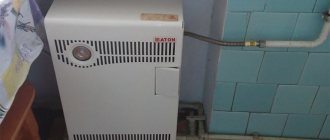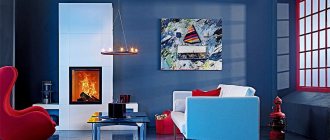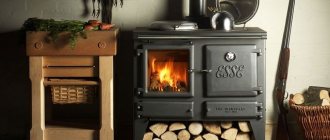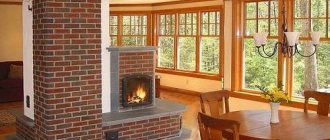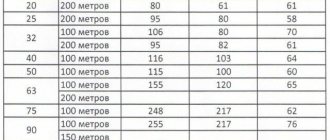The phrase “Stove heating” evokes the warmest memories for many - the native village, grandparents are still alive, fresh milk, carefree childhood holidays... Surprisingly, with age, this type of heating not only has not become outdated, but on the contrary, it has begun to gain popularity. Moreover, stove heating of a private home has begun to be perceived as a fashionable heating option. Moreover, in many regions of Russia, heating a private house on your own is many times more economical and easier than connecting a gas pipeline (which is not available everywhere!) or using electricity (which, by the way, is also turned off!). That is why stove manufacturers try to keep up with modern trends and the demands of their customers. If you study the range of wood-burning stoves on the market, there are really many models, and they all differ from each other. But the key criterion was and remains the material - steel or cast iron. Let's talk about the difference between these two materials...
The fundamental difference between steel wood-burning stoves
Steel stoves come in different varieties, but they all have one thing in common - they heat the room using convection.
Efimov Maxim Store manager on Vyborg highway. 212
Convection (translated from Latin convectiō - “transfer”) is a type of heating of a room when the lower layers of air heat up, become lighter and rise upward. And the air above, on the contrary, cools and sinks. This process is cyclical, which means it repeats again and again.
In other words, the stove takes in cold room air and returns warm air. This property is directly related to the material - steel has a low heat capacity, so it does not retain heat.
The heating option using convection is considered the fastest way to heat a room.
Fig 1. Convection method of heating a room
Steel wood-burning stoves are ideal if you are at your dacha/house for short periods of time, which means you need to quickly warm up the room. After just 20-30 minutes you will feel the cold receding and a pleasant warmth spreading throughout the house...
But steel stoves also have a downside - such stoves cool down as quickly as they heat up. For example, you warmed up the room, went to bed, and by morning you were numb from the cold! After all, you won’t leave a burning stove unattended overnight, and jumping up and checking it every hour is also not convenient. It turns out that in addition to a steel stove, you will also need an electric convector.
One more point needs to be taken into account - the hot steel surface of the furnace, interacting with the air in the room, simply burns oxygen. This, in turn, makes breathing difficult and will definitely not bring joyful feelings to household members. To neutralize this disadvantage, the house will need good supply and exhaust ventilation. In case of its absence, there is also a way out - just periodically open the window for ventilation.
Why do iron stoves heat up faster?
Metal series are less demanding to operate, and since the material has high density and good heat transfer, using such models you can easily heat small rooms. But it is worth remembering that stoves cool down quickly; in order to maintain a comfortable microclimate, you need to constantly maintain combustion.
Combined models are more convenient, since a brick chimney retains heat longer; they are suitable for fairly spacious rooms. This solution has the following advantages:
- no restrictions regarding the choice of location;
- metal options do not require a foundation and have a high degree of mobility;
- compactness, universal availability;
- the ability to dismantle the heating panel during periods of inactivity;
- ease of obtaining permission to operate from regulatory authorities.
Weak sides:
- fire hazard and high risk of injury;
- short service life (up to 5 years, on average) due to the rapid burning of grates and walls.
Metal stoves do not help maintain a comfortable level of humidity; with them it is more difficult to achieve a healthy microclimate in the room.
Types of steel furnaces
Depending on the functional features and appearance, steel furnaces are divided into several types.
Efimov Maxim Store manager on Vyborg highway. 212
We recommend reading our article “How to choose a wood-burning stove for your home.”
Stove-fireplaces. These are stoves with large glass to make it easy to watch the flames. The air intake holes in this type of stove are located at the bottom, often under the firewood door, and the outlet holes are at the top, on the top plate or immediately below it. You will find options for such stoves in the corresponding section of our website.
Fig 2. Stove-fireplace
Long-burning stoves of the “buleryan” type. We described these ovens in detail in a previous article. The body of such furnaces is completely enveloped in tubes for air circulation. Sometimes they are hidden under a cover. The range of stoves of this type is presented in the section “Long-burning stoves”.
Fig. 3. Long-burning furnace of the “buleryan” type
Heating and cooking stoves. This type of stove is a type of long-burning stove. There is a cooking surface on top of such an oven, so convection channels run along the sides. The range of heating and cooking stoves is also presented on our website.
Figure 4. Heating and cooking stove
Potbelly stoves. Let us immediately note that although potbelly stoves are steel ovens, they are not classified as convection ovens. The point is in their design, which historically was and remains as simple as possible - it is a metal box on 4 legs. Potbelly stoves are capable of heating small rooms (most likely even small ones), and at the same time their service life is also short. Nevertheless, even this type of steel furnace has its uses. Models of potbelly stoves can be selected on the website in the “Potbelly stoves” section.
Heated area
It must be recognized that both a brick stove and a metal stove are not the most effective means of heating houses with an area of more than 60 m² (with a ceiling height of up to 3 m). Practice shows that the stove can “cope” with such a volume of air only during off-season periods. It is difficult to achieve a comfortable temperature throughout the house when the outside temperature is -10 °C. Or it is necessary to install several stoves in different parts of the house.
Don't be fooled by the advertising promises of some metal stoves. Statements that the stove is capable of heating 100 m² or more imply a single room not divided into rooms by partitions. A metal stove - a potbelly stove or a fireplace stove - successfully heats only the room in which it is installed. Special convection heating stoves can heat several interconnected rooms, but the temperature between the room in which the stove is installed and the adjacent one will vary greatly.
- 1 of 1
On the picture:
Heating scheme for several rooms with one stove.
Wood burning stoves made of cast iron: advantages and disadvantages
Cast iron stoves heat a room differently than steel stoves. Cast iron is a heat-intensive material that retains heat well. Hence the principle of heating a cast iron stove is infrared. The principle of such heating is that first the oven itself accumulates heat, and then evenly releases it in different directions. As a result, such stoves will take longer to heat the room (about an hour), but at the same time they can be left all night without adding firewood.
Fig 5. Infrared method of heating a room
The second advantage of cast iron is that they do not burn through air. Therefore, the owner of such stoves will need to ventilate the room much less often than in cases with steel stoves.
Brick or metal?
The stove issue needs to be understood by anyone who is one way or another going to solve the problem of heating a house or bathhouse, which are becoming increasingly widespread. The stove market offers a wide range. So what should you choose: brick or metal? Let's look at the pros and cons.
— The brick oven can be built for you the way you want it to be. Metal stoves are usually purchased ready-made, although they can be made to order.
— A brick kiln has a large mass, i.e. stores a lot of heat. It is enough to heat it once or twice a day to keep the house warm around the clock. Brick ovens give off heat from their outer surface, its average temperature does not exceed 65-70°C, and can be heated to a maximum of 90°C. Due to its high heat capacity, brick heat transfer takes much longer than a metal stove.
— The efficiency (Coefficient of Efficiency) in brick kilns reaches 90%; in some parts of the region, the main and perhaps the only source of fuel is wood or coal. In brick kilns, a large percentage of efficiency is achieved due to convective channels (smoke circuits or hoods - after combustion, the smoke passing through them transfers part of the heat to the brick). In metal stoves, firewood flies into the chimney (the effect of a fireplace - it heats while it is being heated).
· The stove is the heart of the home. A brick oven is warm and kind (you won’t get burned), while metal is sometimes hot and sometimes cold. In prefabricated block fireplaces with metal inserts and metal stoves, heat transfer to the air mainly occurs in the internal cavities of metal surfaces heated to significantly high temperatures. On a metal surface, due to the high temperature, much more organic dust sublimes and settles than on a brick surface, and more ions harmful to human health are formed.
· On a brick stove and a brick pipe. Such a pipe does not heat up much, while a hot metal pipe in the attic is out of place (you can, of course, run a metal pipe on the side of the house, but the draft is worse, there is a risk of clogging with soot, and it doesn’t look right). A brick pipe gives a little soft heat throughout the entire time (it hardly heats up, but gives a little heat), while a metal pipe gets very hot during the fire, and quickly cools down later (note that a double-layer metal pipe, i.e. a sandwich, is at a price comparable to the price of a brick one, so in this paragraph I’m talking specifically about a single-layer pipe made of 1mm or 2mm steel).
· Metal burns out after a few years (maximum 10). A brick stove can also break, but in most cases you can independently cover up non-dangerous (i.e. non-smoking) cracks with clay, or the stove maker will repair the stove (in such cases, as a rule, the stove can be operated until the stove maker arrives, observing certain caution). A well-built brick stove, if used properly, will not require repairs before ten years. The service life of a brick oven is 50 years, or even more (with proper operation).
· You can use the stove to heal. Heat has a beneficial effect on the human body. Lovers of light steam know this firsthand. In Rus', ailments have long been treated with the help of stove heat. Moreover, the stove perfectly warms the body and, unlike a bath, is practically not contraindicated for anyone, and is suitable for any age.
The warmth of brickwork warms not only the skin, but also muscles, bones, and joints. With this effect, the body temperature rises to 38.5°C, and pathogenic bacteria and viruses in the body die.
The most important thing is that with the sweat released from the body during heating on the stove, substances such as fat, cholesterol, acids, etc. are removed in much greater quantities than during the bath procedure. This means that such sweating more effectively frees the body from toxins and waste, accelerates metabolism, which has a beneficial effect on muscles and joints, curing cramps, arthritis, rheumatism, and sciatica. And these are not all methods of treatment. The metal stove loses in this sense.
· Another undeniable plus is that food cooked in a brick oven has no analogues. An example of this is the Russian stove.
Bread was baked in it, kvass and beer were brewed, and food supplies were dried on the stove. The food cooked in a Russian oven had excellent taste. This was facilitated by the shape of the dishes, temperature conditions and uniform heating on all sides. In the Russian oven, food was cooked in clay pots and cast iron pots. Both had a narrow neck, a small bottom and large convex sides. The narrow neck reduced evaporation and contact with air, thereby promoting better preservation of vitamins, nutrients and aromatic substances. Food in a Russian oven was cooked almost without boiling due to the fact that the temperature in the oven gradually decreased, because the oven was first heated and then cooked in it. Thus, the food in the Russian oven steamed more or, as they used to say, simmered. Therefore, porridge, pea soups, cabbage soup, etc. turned out to be especially tasty. The Russian stove, having served faithfully for at least 3000 years, has now been transformed into heating and cooking stoves (Swedish, mini Russian stove, hobs with oven). It was replaced by gas and electric stoves, electric grills, microwave ovens, and steamers. But the dishes cooked in them will not replace the taste and aroma of ancient Russian cuisine. And in case of remoteness from the city, and during power outages, all modern appliances become useless, while a brick oven will feed and heat!
· New metal sauna stoves - Finnish and Russian - with which stores are now filled, make it possible to quickly heat a sauna. But the disadvantage of metal is that it cools quickly and also “eats” moisture. The bathhouse turns out dry. Such a bath is bad because it does not heat, but burns. And you don’t get the desired effect in the steam room. It’s hard to breathe in it, your body burns but doesn’t warm up, you steam “dry.” That is why metal stoves are lined with bricks. For sauna heater stoves, the number of stones placed in a metal stove usually does not exceed 80 kg. In addition, they are usually open, i.e. the stones do not heat up properly. A massive brick oven with an internal heater can accommodate 300 kg or more stones, i.e. achieve soft (light) and at the same time powerful (i.e. in sufficient quantity) steam.
In a sauna house, a heater stove (brick sauna stove) can both warm up the steam room and maintain a comfortable temperature in the house in winter, while it is difficult to achieve such versatility from a metal stove. As a result, a metal stove is used as a temporary shelter, or as a way to quickly warm up a small bathhouse, which is not too bad. Sometimes it is not possible to find a good stove maker or there is not enough time and/or funds to build a full-fledged stone stove. Another option is for a person to build himself a large sauna, 7 by 9 meters, from cylinders, and install a metal stove recommended by the company (a little more expensive than usual). At first it’s good, but after 7 years the stove smokes when lit, and the log, i.e. cylindering, torn in places.
· Metal stoves are fire hazardous; according to statistics from the Ministry of Emergency Situations, every 10 fires are caused by improper operation of such stoves.
Conclusion: thus, a brick stove is good for permanent residence (in a bathhouse you should start heating it from lunch, provided that it is already warm), and a metal stove can warm up a steam room in 3 hours. On the other hand, a brick stove retains heat for a long time - if you heat it twice a week, then the stove and steam room do not have time to completely cool down. There is another compromise option: cover the metal stove with bricks.
I note that real steam can only be achieved in a good brick (closed) heater. No Russian or bourgeois metal stoves, regardless of the design and volume of the heater or stones, will give the same soft, strong and at the same time pleasant heat.
From all of the above, a metal stove has more disadvantages than a brick stove, although a brick stove also has some disadvantages. Here are some of them:
- the price of a brick stove is higher than that of a metal stove;
- bulkiness - it is difficult to fit a brick stove in a small garden house measuring 3x3 m;
— a brick kiln cannot be installed without a foundation (a kiln with 1000 bricks weighs 4 tons).
Types of cast iron stoves and their features
There are many options for cast iron stoves, but most likely you will come across two popular types:
- Stove-fireplaces. These are visually beautiful stoves with large heat-resistant glass. As a rule, such stoves have a high body with a low base and a large combustion chamber, above which there is a straight chimney. It provides the necessary thrust for intensive combustion of fuel. The models are presented here.
- Heating and cooking stoves. It is obvious from the name that these ovens have one feature in common - the presence of a hob. The hob can be solid or with burner holes that are closed with rings and disks. The stoves are available in various sizes and are designed to heat rooms from 25 to 150 sq.m. The structures have a horizontal shape, which can accommodate even long firewood.
Figure 6. One of the most popular cast iron stoves Guca Lava
Speed of construction and cost
In these matters, the advantage remains on the side of furnaces made in production. They are relatively light weight and in rare cases require the construction of their own foundation. Factory-made stoves are supplied ready-made: you only need to carry out fire safety work at the installation site, connect and insulate the chimney.
Brick stoves, taking into account the cost of the material and the work of the stove maker, will cost more. The process of their construction is much more complex, lengthy, and dirty. And often you need to think about the construction of a brick oven at the time of building a house (after all, the structure is installed in the partitions). Whereas a metal stove can be brought and installed in a finished building.
Important points when choosing a stove for a country house or cottage.
To summarize, we can summarize the main questions that need to be answered by the owner who wants to heat his country house or dacha.
The main choice is a brick or metal stove
The place where you plan to lay or install
Oven shape and dimensions
What volume needs to be heated?
What set of tasks will need to be solved using the oven (heating, cooking)
Material for masonry and cladding
Available fuel types
What to choose for heating a country house?
In what case is it better to build a brick oven?
Brick heat-intensive stove.
- It is advisable to build a brick stove if the room is planned to be heated only by a stove.
- I recommend building a brick oven only if you have the ability to withstand the heating regime. (heat the stove periodically)
- If you have the opportunity to install a reliable foundation for the furnace.
In order to confidently say that a brick oven is your option, these three conditions must be met.
Let's compare
You can determine for yourself which of the two fireplaces presented is better after comparing the main characteristics.
- Operational life. Branded, expensive models of cast iron options can boast of a long service life. With regular use, a brick hearth begins to deteriorate 5-7 years after laying. Cast iron models can provide heat for more than 15 years. But a lot depends on the manufacturer and the chosen model. If the doors were originally installed
If a brick fireplace
is crooked and has poor details, you should not expect long service life from such a fireplace. Therefore, when purchasing, carefully inspect the condition of the unit, the strength of fastening of the parts, and make sure there are no chips or cracks. - Appearance. In terms of aesthetics, a brick oven is definitely better. It can be built taking into account personal preferences, based on the style of the interior. But the appearance of its cast-iron counterpart scares off many. But it’s up to you to decide which fireplace is more beautiful.
- Installation. Installing a cast iron fireplace is much easier. This is explained by the ready-made design, which can be bought in the store. A qualified team will complete all the work in 3-5 days. To get a brick fireplace, you will need to find a competent stove maker (which is a rarity these days), draw up a diagram of the future hearth, open the floors, pour the foundation, and lay out the bricks. The material must be laid evenly, each layer is checked by the building level. One mistake made during the laying process will affect the operation of the fireplace.
- Price. At this point, the cast iron fireplace wins again. The cost of construction and installation is significantly lower than the price of bricks and the work of layers. If a metal stove will cost you, on average, 20 thousand rubles, then its competitor will require investments 2-3 times more.
Cast iron fireplace - Environmentally friendly. When heated, brick does not emit unpleasant odors or dangerous fumes. But when metal particles burn out, they are sprayed into the air, negatively affecting the atmosphere in the house.
- Mobility. The cast iron fireplace is heavy, but mobile. If desired, it can be moved to another room. To do this, you will have to change the location of the chimney. The brick hearth cannot be moved from its place. There is only one procedure for it - dismantling, that is, demolition.
- Purchase. Cast iron samples are presented in specialized stores. This allows you to buy a fireplace right away. It takes time to create a brick hearth.
- Heating capabilities. Both fireplaces perfectly perform their main function - heating the rooms. But there is one important difference: cast iron heats up slowly, but retains heat for a long time. Brick, on the contrary, heats up quickly, but also cools down just as quickly. You need to choose according to this criterion taking into account where the fireplace will be installed. For dachas and country properties, a brick model is suitable, allowing you to quickly get warmth when moving into the house. And in order to obtain constant heating from the fireplace, it is better to purchase a cast iron version.
[ads-pc-2][ads-mob-2]
Do-it-yourself stove heating with a water circuit, step-by-step construction
First, before you start building the stove, you need to prepare the foundation. To do this, you need to dig a pit, the depth of which is 150–200 millimeters. Fill the bottom with layers of broken brick, crushed stone and rubble. Then fill everything with cement mortar. The foundation should rise several centimeters above the floor. Place waterproofing material on the screed.
Construction process of a water loop furnace
Main features of brick laying
The stove must be built from quality materials. Walls can be built from bricks with normal firing, but for the firebox, purchase refractory bricks.
- Before starting laying, the bricks must be wetted. To do this, immerse them in water for a while. When air bubbles stop coming out of them, you can start laying.
- All rows and corners must be tied.
- Apply the cement mortar to the entire rad at once. Its layer should be about 5 millimeters. Refresh the mortar on the end right before laying brick on it.
- When you get to the firebox, don't apply the clay with a trowel. Do it with your hands.
- Every five rows, carefully cut off excess cement from the seams and wipe them with a damp sponge.
- The walls of the stove must be vertical and horizontal. Use a spirit level constantly during laying to check this.
Temperature control methods
If you need to regulate the temperature of the coolant, which is heated by a furnace with a water heating system, then this is quite simple to do. There are three main ways here:
- Using a blower damper. This is an excellent option that allows you to both reduce and increase the heating intensity of the liquid, as well as regulate the temperature in the room.
- Increase in the volume of fuel burned. Of course, this method is only possible when it is necessary to raise the temperature of the coolant in the heating system to a specific value.
- Circulation pump device. This equipment pumps water or antifreeze throughout the entire system, thereby ensuring high-quality heating of pipelines and radiators.
Conclusion
Everyone makes the decision to choose a stove for a brick or iron bath independently. It is clear that metal construction is cheaper . It takes up little space and can be installed independently. But for those who want to experience all the delights of a real Russian bathhouse , it is advisable to choose a brick stove. It is quite good, allows you to steam without having to monitor the temperature, and is also healthier than iron.
If you were able to make a decision, then take a stainless steel metal stove, it is inexpensive and practical.
